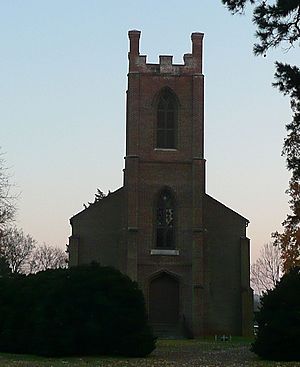St. John's Episcopal Church (Ashwood, Tennessee) facts for kids
Quick facts for kids |
|
|
St John's Episcopal Church
|
|

Front of St. John's Church
|
|
| Nearest city | Columbia, Tennessee |
|---|---|
| Built | 1839-1842 |
| Architect | Leonidas Polk |
| Architectural style | Gothic Revival |
| NRHP reference No. | 70000615 |
| Added to NRHP | July 8, 1970 |
St. John's Episcopal Church is a very old and important church in Ashwood, Maury County, Tennessee. It was built a long time ago, between 1839 and 1842, by a bishop named Leonidas Polk.
This church was very active before the American Civil War (1861–1865). During the war, it was damaged and then used as a hospital for soldiers. After the war, church services started again. However, they stopped in 1915 because not many people attended. Today, the church is mostly closed, except for one special event each year.
Contents
Where is St. John's Church?
The church is located about six miles southwest of Columbia, Tennessee. It sits in a quiet area of Maury County.
The Story of St. John's Church
The land where the church stands once belonged to Colonel William Polk. His son, Leonidas Polk, was a church leader, called a rector. He held church services in his own home, Ashwood Hall, from 1834 to 1838. Because he wasn't always well, another church leader, James Hervey Otey, helped him.
In 1839, Leonidas Polk decided to build a proper church building. It was built where a tall cherry tree once stood. This tree was cut down, and its wood was used to make parts of the church inside, like the balcony. The church was designed in a style called Gothic Revival. This style looks like old European churches. It was inspired by a church in England and another one in North Carolina.
The church was built by African slaves owned by Polk and his family. It was finished in the summer of 1842. A special ceremony, called a consecration, took place on September 4, 1842.
The first full-time pastor, Stephen Patterson, started in 1845. Both white and Black people attended services at the church. A new rector, E. H. Cressy, took over in 1848. The church bell was put in the tower in 1849. By 1858, James Hildebrand became the new rector. Important people, like Mary Elizabeth Martin and her son, attended services there.
St. John's During the Civil War
During the American Civil War, in March 1862, Union soldiers entered the church. They damaged it and broke its windows. By 1864, the church was turned into a hospital for soldiers.
Days before a big battle in Franklin in November 1864, a general named Patrick Cleburne passed by St. John's. He was so impressed by its beauty that he said it would be a beautiful place to be buried. Leonidas Polk, who built the church, was actually buried in a special room inside the church in 1864.
After the war, in 1872, Richard N. Newell became the new rector. However, church services stopped in 1915 because not enough people were coming.
In 1945, Leonidas Polk's remains were moved from St. John's Church. He was re-buried in a cathedral in New Orleans, Louisiana.
Today, St. John's Episcopal Church is not an active church for regular services. It is only used once a year for a special service. There is also a graveyard next to the church. Four important church leaders, called Bishops of Tennessee, are buried there.
Why is it Important?
St. John's Episcopal Church is considered a very important historical site. It has been listed on the National Register of Historic Places since 1970. This means it is recognized for its special history and architecture.




